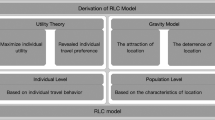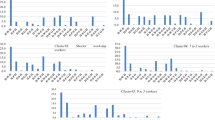Abstract
The spatial mismatch between jobs and housing in cities creates long daily travels that exacerbate climate change, air pollution, and traffic congestion. Yet, not enough research on occupational differences has been done. This study first applies the Hidden Markov Mixture Model (H3M) to model travel patterns for different occupation groups in Hong Kong. Then, the Variational Bayesian Hierarchical EM algorithm is used to identify common lifestyle clusters. Next, a binary logistic regression is developed to examine whether the lifestyle clusters can be explained by jobs-housing balance. This study is among the first to consider travel patterns as a Markov process and apply H3M to examine jobs-housing balance by fine-grain occupation group. The method is transferable and universally applicable; and the results provide occupation-specific insights on jobs-housing balance in an Asian context. The research findings suggest that different occupation groups have different travel patterns in Hong Kong. Two lifestyle clusters, “balanced and compact activity space” and “work-oriented and extensive travels”, are unveiled. Notably, the latter is associated a lower level of jobs-housing balance. Some occupations in the quaternary industry (“information and communications”, “profession, science and technology”, “real estate”, and “finance and insurance”) are having more serious jobs-housing imbalance. The paper concludes with a discussion on improving the occupation-specific jobs-housing balance in accordance with Hong Kong’s future development goals.






Similar content being viewed by others
References
Adams-Prassl, A., Boneva, T., Golin, M., Rauh, C.: Work that can be done from home: evidence on variation within and across occupations and industries. Labour Econ. 74, 102083 (2022). https://doi.org/10.1016/j.labeco.2021.102083
Alexander, B., Dijst, M.: Professional workers @ work: Importance of work activities for electronic and face-to-face communications in the Netherlands. Transportation 39(5), 919–940 (2012). https://doi.org/10.1007/s11116-012-9400-2
Blumenberg, E., King, H.: Jobs-housing balance re-re-visited. J. Am. Plann. Assoc. 87(4), 484–496 (2021). https://doi.org/10.1080/01944363.2021.1880961
Census and Statistics Department. Table E2011C : 2011 Population Census—Main Tables (Economic). Census and Statistics Department (2012). https://www.censtatd.gov.hk/en/scode170.html#section3
Cervero, R.: Jobs-housing balancing and regional mobility. J. Am. Plann. Assoc. 55(2), 136–150 (1989). https://doi.org/10.1080/01944368908976014
Cervero, R.: Jobs-Housing Balance Revisited: Trends and Impacts in the San Francisco Bay Area. J. Am. Plann. Assoc. 62(4), 492–511 (1996). https://doi.org/10.1080/01944369608975714
Chuk, T., Chan, A.B., Hsiao, J.H.: Understanding eye movements in face recognition using hidden Markov models. J. vis. 14(11), 8 (2014). https://doi.org/10.1167/14.11.8
Gera, S., Kuhn, P.: Occupation and the journey-to-work: Some further analysis. Socioecon. Plann. Sci. 15(2), 83–93 (1981). https://doi.org/10.1016/0038-0121(81)90053-7
Giuliano, G.: IS JOBS-HOUSING BALANCE A TRANSPORTATION ISSUE? Transp. Res. Rec. 1305 (1991). https://trid.trb.org/view/365647
Giuliano, G., Small, K.A.: Is the journey to work explained by urban structure? Urban Stud. 30(9), 1485–1500 (1993). https://doi.org/10.1080/00420989320081461
Golledge, R.G.: Spatial Behavior: A Geographic Perspective. Guilford Press (1997)
Hägerstraand, T.: What about people in regional science? Pap. Reg. Sci. 24(1), 7–24 (1970). https://doi.org/10.1111/j.1435-5597.1970.tb01464.x
Hong Kong Special Administrative Region.: The Chief Executive’s 2022 Policy Address (2022). https://www.policyaddress.gov.hk/2022/en/policy.html
Horner, M.W.: Extensions to the concept of excess commuting. Environ. Plann. a econ.and Space 34(3), 543–566 (2002). https://doi.org/10.1068/a34126
Huang, Z., Loo, B.P.Y., Axhausen, K.W.: Travel behaviour changes under Work-from-home (WFH) arrangements during COVID-19. Travel Behaviour and Society, 30, 202–211 (2023). https://doi.org/10.1016/j.tbs.2022.09.006
Jiang, S., Ferreira, J., Gonzalez, M.C.: Clustering daily patterns of human activities in the city. Data Min. Knowledge Discov. (2012). https://doi.org/10.1007/s10618-012-0264-z
Kersting, M., Matthies, E., Lahner, J., Schlüter, J.: A socioeconomic analysis of commuting professionals. Transportation 48(5), 2127–2158 (2021). https://doi.org/10.1007/s11116-020-10124-w
Lan, H., Liu, Z., Hsiao, J.H., Yu, D., Chan, A.B.: Clustering hidden Markov models with variational Bayesian hierarchical EM. IEEE Trans. Neural Netw. Learn. Syst. (2021). https://doi.org/10.1109/TNNLS.2021.3105570
Lanzendorf, M.: Mobility styles and travel behavior: application of a lifestyle approach to leisure travel. Transp. Res. Rec. 1807(1), 163–173 (2002). https://doi.org/10.3141/1807-20
Lee, W.: Assessing the impacts of job and worker relocation policies on commuting. Appl. Geogr. 34, 606–613 (2012). https://doi.org/10.1016/j.apgeog.2012.03.004
Li, Y., Geertman, S., Hooimeijer, P., Lin, Y., Yang, H., Yang, L.: Interaction effects of socioeconomic factors on long-distance commuting after disentangling residential self-selection: an empirical study in Xiamen, China. J. Transp. Geogr. 105, 103481 (2022). https://doi.org/10.1016/j.jtrangeo.2022.103481
Loo, B.P.Y., Chow, A.S.Y.: Spatial restructuring to facilitate shorter commuting: an example of the relocation Of Hong Kong international airport. Urban Stud. 48(8), 1681–1694 (2011a). https://doi.org/10.1177/0042098010375319
Loo, B.P.Y., Chow, A.S.Y.: Jobs-housing balance in an era of population decentralization: an analytical framework and a case study. J. Transp. Geogr. 19(4), 552–562 (2011b). https://doi.org/10.1016/j.jtrangeo.2010.06.004
Loo, B.P.Y., Lam, W.: A multilevel investigation of differential individual mobility of working couples with children: a case study of Hong Kong. Transportmetrica 9, 1–24 (2011). https://doi.org/10.1080/18128602.2011.643509
Loo, B.P.Y., Zhang, F., Hsiao, J.H., Chan, A.B., Lan, H.: Applying the hidden markov model to analyze urban mobility patterns: an interdisciplinary approach. Chin. Geogr. Sci. 31(1), 1–13 (2021). https://doi.org/10.1007/s11769-021-1173-0
Lv, Q., Mei, Z., Qiao, Y., Zhong, Y., Lei, Z.: Hidden Markov model based user mobility analysis in LTE network. In: 2014 International Symposium on wireless personal multimedia communications (WPMC), 379–384 (2014). https://doi.org/10.1109/WPMC.2014.7014848
Ma, X., Liu, C., Wen, H., Wang, Y., Wu, Y.-J.: Understanding commuting patterns using transit smart card data. J. Transp. Geogr. 58, 135–145 (2017). https://doi.org/10.1016/j.jtrangeo.2016.12.001
Maoh, H., Tang, Z.: Determinants of normal and extreme commute distance in a sprawled midsize Canadian city: evidence from Windsor, Canada. J. Transp. Geogr. 25, 50–57 (2012). https://doi.org/10.1016/j.jtrangeo.2012.07.003
Manaugh, K., Miranda-Moreno, L.F., El-Geneidy, A.M.: The effect of neighbourhood characteristics, accessibility, home–work location, and demographics on commuting distances. Transportation 37(4), 627–646 (2010). https://doi.org/10.1007/s11116-010-9275-z
Niedzielski, M.A., O’Kelly, M.E., Boschmann, E.E.: Synthesizing spatial interaction data for social science research: validation and an investigation of spatial mismatch in Wichita, Kansas. Comput. Environ. Urban Syst. 54, 204–218 (2015). https://doi.org/10.1016/j.compenvurbsys.2015.09.004
O’Kelly, M., Lee, W.: Disaggregate journey-to-work data: implications for excess commuting and jobs-housing balance. Environ. Plan A 37, 2233–2252 (2005). https://doi.org/10.1068/a37312
O’Kelly, M.E., Niedzielski, M.A., Gleeson, J.: Spatial interaction models from Irish commuting data: variations in trip length by occupation and gender. J. Geogr. Syst. 14(4), 357–387 (2012). https://doi.org/10.1007/s10109-011-0159-3
Openshaw, S.: Ecological fallacies and the analysis of areal census data. Environ. Plan A 16(1), 17–31 (1984)
Penco, L.: The development of the successful city in the knowledge economy: toward the dual role of consumer hub and knowledge hub. J. Knowl. Econ. 6(4), 818–837 (2015). https://doi.org/10.1007/s13132-013-0149-4
Peng, Z.-R.: The jobs-housing balance and urban commuting. Urban Stud. 34(8), 1215–1235 (1997). https://doi.org/10.1080/0042098975600
Pereira, R. H. M., Schwanen, T.: Commute time in Brazil (1992–2009): differences between metropolitan areas, by income levels and gender (Working Paper No. 192). Discussion Paper (2015). https://www.econstor.eu/handle/10419/220280
Prillwitz, J., Barr, S.: Moving towards sustainability? Mobility styles, attitudes and individual travel behaviour. J. Transp. Geogr. 19(6), 1590–1600 (2011). https://doi.org/10.1016/j.jtrangeo.2011.06.011
Qi, Y., Paisley, J.W., Carin, L.: Music analysis using hidden markov mixture models. IEEE Trans. Signal Process. 55(11), 5209–5224 (2007). https://doi.org/10.1109/TSP.2007.898782
Sang, S., O’Kelly, M., Kwan, M.P.: Examining commuting patterns: results from a journey-to-work model disaggregated by gender and occupation. Urban Studies, 48, 891–909 (2011). https://doi.org/10.1177/0042098010368576
Schleith, D., Widener, M., Kim, C.: An examination of the jobs-housing balance of different categories of workers across 26 metropolitan regions. J. Transp. Geogr. 57, 145–160 (2016). https://doi.org/10.1016/j.jtrangeo.2016.10.008
Selstad, T.: The rise of the quaternary sector: the regional dimension of knowledge-based services in Norway, 1970–1985. Norsk Geografisk Tidsskrif Norwegian J. Geogr. 44(1), 21–37 (1990). https://doi.org/10.1080/00291959008552242
Shi, H., Cao, H., Zhou, X., Li, Y., Zhang, C., Kostakos, V., Sun, F., Meng, F: Semantics-aware hidden markov model for human mobility. In: Proceedings of the 2019 SIAM international conference on data mining (SDM), 774–782 (2019). https://doi.org/10.1137/1.9781611975673.87
Smyth, P.: Clustering sequences with hidden Markov models. In: Proceedings of the 9th international conference on neural information processing systems, 648–654 (1996)
Van Winden, W.: Urban governance in the knowledge-based economy: challenges for different city types. Innov. Org. Manag. 10(2–3), 197–210 (2008). https://doi.org/10.5172/impp.453.10.2-3.197
Yue, L., O’Kelly, M.E.: Variations in excess commuting by educational and occupational worker subgroups: a case study of Shanghai. Socio-Econ. Plann. Sci. (2023). https://doi.org/10.1016/j.seps.2023.101518
Zhang, F., Loo, B.P.Y.: Transport demand management. Int. Encycl. Transp. (2021). https://doi.org/10.1016/b978-0-08-102671-7.10380-x
Zhang, M., He, S., Zhao, P.: Revisiting inequalities in the commuting burden: institutional constraints and job-housing relationships in Beijing. J. Transp. Geogr. 71, 58–71 (2018). https://doi.org/10.1016/j.jtrangeo.2018.06.024
Zhao, P., Lü, B., de Roo, G.: Urban expansion and transportation: the impact of urban form on commuting patterns on the city fringe of Beijing. Environ. Plann. A: Econ. Space 42(10), 2467–2486 (2010). https://doi.org/10.1068/a4350
Zhou, X., Yeh, A.G., Li, W., Yue, Y.: A commuting spectrum analysis of the jobs–housing balance and self-containment of employment with mobile phone location big data. Environ. Plann. b Urban Anal. City Sci. 45(3), 434–451 (2018). https://doi.org/10.1177/2399808317707967
Zhou, Y., Yuan, Q., Yang, C., Wang, Y.: Who you are determines how you travel: clustering human activity patterns with a Markov-chain-based mixture model. Travel Behav. Soc. 24, 102–112 (2021). https://doi.org/10.1016/j.tbs.2021.03.005
Zhu, W., Zhang, C., Yao, S., Gao, X., Han, J.: A spherical hidden markov model for semantics-rich human mobility modeling. [Cs, Stat] (2020). http://arxiv.org/abs/2010.01986
Author information
Authors and Affiliations
Contributions
FZ: Formal analysis; methodology; data curation; writing—original draft. BPYL: Conceptualization; methodology; resources; supervision; writing—original draft, review and editing. HL: Methodology; software; validation. ABC: Methodology; software; resources. JHH: Methodology; software; resources.
Corresponding author
Ethics declarations
Conflict of interest
The authors have no competing interests to declare.
Additional information
Publisher's Note
Springer Nature remains neutral with regard to jurisdictional claims in published maps and institutional affiliations.
Appendix A
Rights and permissions
Springer Nature or its licensor (e.g. a society or other partner) holds exclusive rights to this article under a publishing agreement with the author(s) or other rightsholder(s); author self-archiving of the accepted manuscript version of this article is solely governed by the terms of such publishing agreement and applicable law.
About this article
Cite this article
Zhang, F., Loo, B.P.Y., Lan, H. et al. Jobs-housing balance and travel patterns among different occupations as revealed by Hidden Markov mixture models: the case of Hong Kong. Transportation (2023). https://doi.org/10.1007/s11116-023-10390-4
Accepted:
Published:
DOI: https://doi.org/10.1007/s11116-023-10390-4




